INSTITUT SUPERIEUR D'ANTHROPOLOGIE
INSTITUTE OF ANTHROPOLOGY
ONLINE COURSES / COURS A DISTANCE
NEW OPEN COURSE : JANUARY 2013
HRM 104 : INTRODUCTION TO INTANGIBLE CULTURAL HERITAGE
REGISTER NOW
PAKISTAN – 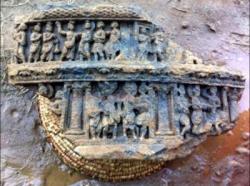 Barikot - A team of Italian archaeologists has set off to Pakistan to study information on the life of Buddha found in a recently discovered temple in the city of Barikot, in the Swat Valley. The temple, known as a Vihara, contains two bas-reliefs experts believe date back to the Kushana period between the first and third centuries BC. The Swat valley is on the border with Afghanistan One of the masterpieces depict the silent escape of Siddhartha from the city, on horseback with followers. The other depicts the 'Great Renunciation' scene, where Siddhartha, the birth name of Gautama Buddha, leaves his nuptial bed, and is taken to symbolize his leaving his wife and all ties with worldly life, according to Bari archaeologist Francesco Genchi, who is part of the team. Also in the Swat valley, another group of Italian archaeologists led by Luca Olivieri have unearthed 23 graves in what is now known as the Udegram necropolis. Some of the tombs are in excellent conditions and contain stone rooms, relatively intact human remains, vases and other items of daily use.
Barikot - A team of Italian archaeologists has set off to Pakistan to study information on the life of Buddha found in a recently discovered temple in the city of Barikot, in the Swat Valley. The temple, known as a Vihara, contains two bas-reliefs experts believe date back to the Kushana period between the first and third centuries BC. The Swat valley is on the border with Afghanistan One of the masterpieces depict the silent escape of Siddhartha from the city, on horseback with followers. The other depicts the 'Great Renunciation' scene, where Siddhartha, the birth name of Gautama Buddha, leaves his nuptial bed, and is taken to symbolize his leaving his wife and all ties with worldly life, according to Bari archaeologist Francesco Genchi, who is part of the team. Also in the Swat valley, another group of Italian archaeologists led by Luca Olivieri have unearthed 23 graves in what is now known as the Udegram necropolis. Some of the tombs are in excellent conditions and contain stone rooms, relatively intact human remains, vases and other items of daily use.
http://www.lagazzettadelmezzogiorno.it/notizia.php?IDNotizia=571170&IDCategoria=2694
INDE –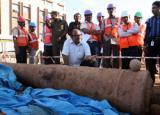 Bangalore - Workers digging the ground for Bangalore Metro line at K R Market in the early hours of Thursday, stumbled upon a 12-feet cannon and a cannon ball belonging to Tipu Sultan era. Keshava T M, the deputy superintending archeologist, excavation branch of the Archeological Survey of India (ASI), who examined the cannon after being informed of the find, said the gun was made of iron and belonged to the 18th century. The archeological artefact was found four metres below the ground.
Bangalore - Workers digging the ground for Bangalore Metro line at K R Market in the early hours of Thursday, stumbled upon a 12-feet cannon and a cannon ball belonging to Tipu Sultan era. Keshava T M, the deputy superintending archeologist, excavation branch of the Archeological Survey of India (ASI), who examined the cannon after being informed of the find, said the gun was made of iron and belonged to the 18th century. The archeological artefact was found four metres below the ground.
http://www.deccanherald.com/content/293895/metro-dig-unearths-12-ft.html
USA – 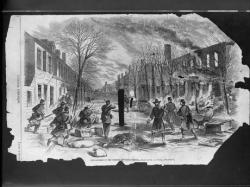 Fredericksburg - Perhaps the Yankee boys from Company C had tumbled into the basement on Princess Anne Street to escape the rebel snipers hidden in the ruined buildings outside. Maybe they had sought refuge after the suicidal slaughter on the nearby heights, where the Confederates packed behind a stone wall had mowed down rank upon rank of charging Union lads. Or maybe they were among the Northern soldiers who pillaged Fredericksburg as the battle here unfolded in a federal defeat. All the archaeologists have to go on are the things they left behind — bullets, charred clay pipe bowls, buckles, buttons and other refuse of war. Last month, experts finished unearthing, in the basement of a long-vanished house, a trove of artifacts that appears to date from the Civil War's Battle of Fredericksburg — 150 years ago next month. Thousands of items, dropped, discarded or forgotten, were dug from the site, which became sealed in time after the Union army retreated from the December 1862 battle, and the house on the site burned down. They were tantalizing finds — bullets that had been unloaded from muskets; two brass letters, "C," likely from Union hats; two number "2" insignia, perhaps indicating the soldiers' regiment. There were also knapsack hooks, the finial from a cartridge box, and the remains of ration tins, almost all of it the equipment of Yankee soldiers, archaeologists said.
Fredericksburg - Perhaps the Yankee boys from Company C had tumbled into the basement on Princess Anne Street to escape the rebel snipers hidden in the ruined buildings outside. Maybe they had sought refuge after the suicidal slaughter on the nearby heights, where the Confederates packed behind a stone wall had mowed down rank upon rank of charging Union lads. Or maybe they were among the Northern soldiers who pillaged Fredericksburg as the battle here unfolded in a federal defeat. All the archaeologists have to go on are the things they left behind — bullets, charred clay pipe bowls, buckles, buttons and other refuse of war. Last month, experts finished unearthing, in the basement of a long-vanished house, a trove of artifacts that appears to date from the Civil War's Battle of Fredericksburg — 150 years ago next month. Thousands of items, dropped, discarded or forgotten, were dug from the site, which became sealed in time after the Union army retreated from the December 1862 battle, and the house on the site burned down. They were tantalizing finds — bullets that had been unloaded from muskets; two brass letters, "C," likely from Union hats; two number "2" insignia, perhaps indicating the soldiers' regiment. There were also knapsack hooks, the finial from a cartridge box, and the remains of ration tins, almost all of it the equipment of Yankee soldiers, archaeologists said.
http://www.independent.co.uk/news/world/americas/civil-war-battle-rises-from-the-ruins-of-old-fredericksburg-8348011.html
TURQUIE – 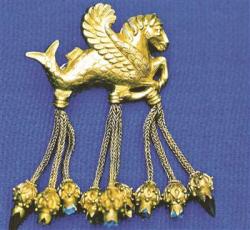 Uşak - A winged seahorse brooch from the Lydian Hoard has been found in Germany, Culture and Tourism Minister Ertuğrul Günay said at Istanbul’s TÜYAP Book Fair yesterday. The brooch, the most important piece of the famous Karun Treasure, had been stolen from a display at the Uşak Archaeology Museum in 2005.
Uşak - A winged seahorse brooch from the Lydian Hoard has been found in Germany, Culture and Tourism Minister Ertuğrul Günay said at Istanbul’s TÜYAP Book Fair yesterday. The brooch, the most important piece of the famous Karun Treasure, had been stolen from a display at the Uşak Archaeology Museum in 2005.
http://www.hurriyetdailynews.com/karun-piece-found-in-germany.aspx?pageID=238&nID=35155&NewsCatID=375
GRECE – 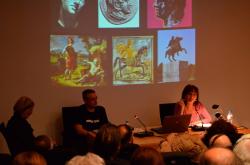 A virtual museum dedicated to Alexander the Great. A museum accessible to every visitor, from any part of the globe, invited to wander among Alexander’s world, the way it has been formed and it has changed throughout time. A museum giving scientifically documented information, offering the users the possibility to discuss on relevant matters (forum) and the archaeologists to inform of their work, be it excavations or research in general. The tour will start from Macedonia and Alexander’s roots, will continue by presenting the personality, the accomplishments and the vision of Philip II, it will then move to Alexander himself. His birth, his education by the great philosopher Aristotle, his first deeds and his rise to the throne, after his father’s murder. Follows the presentation of his impressive expedition to the East that started at Aigai and was destined to change the world for ever. This has been the vision of both Dr. Angeliki Kottaridi and the 17th EPCA, and this vision fueled an avant-garde experiment: the creation of the “Virtual Museum Alexander the Great: from Aigai to the Universe.”
A virtual museum dedicated to Alexander the Great. A museum accessible to every visitor, from any part of the globe, invited to wander among Alexander’s world, the way it has been formed and it has changed throughout time. A museum giving scientifically documented information, offering the users the possibility to discuss on relevant matters (forum) and the archaeologists to inform of their work, be it excavations or research in general. The tour will start from Macedonia and Alexander’s roots, will continue by presenting the personality, the accomplishments and the vision of Philip II, it will then move to Alexander himself. His birth, his education by the great philosopher Aristotle, his first deeds and his rise to the throne, after his father’s murder. Follows the presentation of his impressive expedition to the East that started at Aigai and was destined to change the world for ever. This has been the vision of both Dr. Angeliki Kottaridi and the 17th EPCA, and this vision fueled an avant-garde experiment: the creation of the “Virtual Museum Alexander the Great: from Aigai to the Universe.”
http://www.archaiologia.gr/en/
ITALIE –  Rome - After extensive restoration, Rome plans to reopen the ancient tunnels below the Baths of Caracalla that connect to the largest Mithraic temple in the Roman Empire. The popular mystery religion Mithraism is named after the deity Persian Mithra, and was practiced for centuries across Roman Europe. While those who celebrated the Mithraic Mysteries worshipped the other gods in the Roman pantheon, their rituals were considered similar to those practiced by early Christians, who considered Mithraism a threat to the development of Christianity. The Roman Mithraeum was discovered last year and its sparse decoration includes a fresco of the deity along with a delineated space for the sacrifice of a bull. The restoration of the underground tunnels will be complete in December, and tourists will have access to the extensive tunnel network underneath one of Rome’s most luxurious public baths. The third-century C.E. underground passageways suffered from extensive algae damage after skylights were opened in the ceilings, and the new restoration replaces the open spaces with artificial lighting. The Mithraeum itself was recently reopened after a year of restoration work, and is due to be connected with the underground tunnels to form a single underground route for tourists.
Rome - After extensive restoration, Rome plans to reopen the ancient tunnels below the Baths of Caracalla that connect to the largest Mithraic temple in the Roman Empire. The popular mystery religion Mithraism is named after the deity Persian Mithra, and was practiced for centuries across Roman Europe. While those who celebrated the Mithraic Mysteries worshipped the other gods in the Roman pantheon, their rituals were considered similar to those practiced by early Christians, who considered Mithraism a threat to the development of Christianity. The Roman Mithraeum was discovered last year and its sparse decoration includes a fresco of the deity along with a delineated space for the sacrifice of a bull. The restoration of the underground tunnels will be complete in December, and tourists will have access to the extensive tunnel network underneath one of Rome’s most luxurious public baths. The third-century C.E. underground passageways suffered from extensive algae damage after skylights were opened in the ceilings, and the new restoration replaces the open spaces with artificial lighting. The Mithraeum itself was recently reopened after a year of restoration work, and is due to be connected with the underground tunnels to form a single underground route for tourists.
http://www.biblicalarchaeology.org/daily/news/the-underside-of-ancient-rome/